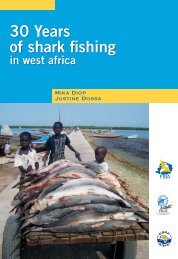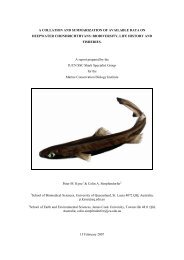Magazine of the species survival Commission specialist Group - IUCN
Magazine of the species survival Commission specialist Group - IUCN
Magazine of the species survival Commission specialist Group - IUCN
You also want an ePaper? Increase the reach of your titles
YUMPU automatically turns print PDFs into web optimized ePapers that Google loves.
<strong>specialist</strong> group exchange<br />
and to promote wider collaboration<br />
between nations.<br />
The Eurasian Otter (Lutra lutra) is<br />
listed as Near Threatened on <strong>the</strong> <strong>IUCN</strong><br />
Red List. Across most <strong>of</strong> its range in<br />
Europe, <strong>the</strong> populations are subjected<br />
to considerable mortality due to road<br />
traffic accidents and o<strong>the</strong>r humanrelated<br />
activities. In some countries,<br />
information on mortality locations and<br />
carcasses are collected systematically<br />
to guide conservation efforts. However,<br />
<strong>the</strong> standard <strong>of</strong> information from postmortem<br />
analysis and, sample collection<br />
varies widely between countries.<br />
As <strong>the</strong> otter is protected throughout<br />
Europe <strong>the</strong> carcasses from <strong>the</strong>se<br />
accidental killings are a valuable source<br />
<strong>of</strong> information, e.g. on population health<br />
and exposure to contamination, that<br />
can be used to assess <strong>the</strong> conservation<br />
status <strong>of</strong> populations and <strong>the</strong> effects <strong>of</strong><br />
conservation efforts.<br />
The development <strong>of</strong> standardized<br />
post-mortem analysis and sample<br />
storage, and a database on tissue<br />
banks, will enable closer cooperation<br />
and more detailed pan-European<br />
studies. Ultimately, this should result in<br />
more efficient management tools and<br />
conservation plans for otters.<br />
The post-mortem protocol will be<br />
presented at <strong>the</strong> next international Otter<br />
Conference in Pavia, Italy, in 2011.<br />
The workshop has been arranged in<br />
conjunction with The Swedish Museum<br />
<strong>of</strong> Natural History and <strong>the</strong> National<br />
Environmental Research Institute,<br />
Aarhus University, Denmark.<br />
Lesley Wright<br />
Member, Otter Specialist <strong>Group</strong><br />
Peccary SG<br />
Regular <strong>IUCN</strong> Red List updates<br />
planned<br />
The new Peccary Specialist <strong>Group</strong><br />
(previously part <strong>of</strong> <strong>the</strong> Peccaries and<br />
Hippos Specialist <strong>Group</strong>) is co-chaired<br />
by Harald Beck and Mariana Altrichter.<br />
Currently, our group has approximately<br />
40 members from 16 different<br />
countries, including researchers from<br />
many biological disciplines,<br />
veterinarians, zoo experts, and<br />
conservation organizations. This<br />
diversity and expertise gives <strong>the</strong> group<br />
a very strong base to advance<br />
Chacoan Peccary (Catagonus wagneri).<br />
© Leonardo Maffei<br />
collaborations, our understanding <strong>of</strong><br />
peccaries and to work for <strong>the</strong>ir<br />
conservation.<br />
Peccaries are classified as<br />
ecosystem engineers, <strong>species</strong> that<br />
physically create or modify existing<br />
environments, <strong>the</strong>reby changing <strong>the</strong><br />
availability <strong>of</strong> resources for o<strong>the</strong>r<br />
<strong>species</strong>. As seed dispersers, seed<br />
predators, and engineers <strong>of</strong> freshwater<br />
habitats, peccaries play an immense,<br />
long-overlooked role in ecosystems.<br />
Our short-term goals are to<br />
coordinate work among members for<br />
regular updating <strong>of</strong> <strong>the</strong> <strong>IUCN</strong> Red List,<br />
create an interactive web page for <strong>the</strong><br />
group, and compile a “virtual library”<br />
with all published literature related to<br />
peccary research. We also need to<br />
create a new Species Conservation<br />
Plan to replace <strong>the</strong> existing 1993<br />
Species Action Plan.<br />
Several <strong>of</strong> <strong>the</strong> members <strong>of</strong> <strong>the</strong><br />
group have worked very hard for <strong>the</strong><br />
past three years to finish <strong>the</strong> report on<br />
<strong>the</strong> Range-Wide Status Assessment for<br />
White-Lipped Peccaries. This is one <strong>of</strong><br />
<strong>the</strong> most data-rich assessments ever<br />
undertaken for such a wide-ranging<br />
<strong>species</strong>. It is hoped that this study will<br />
play an active role in conservation<br />
planning. This report has already been<br />
distributed among governmental and<br />
non-governmental agencies in Latin<br />
America and to universities,<br />
researchers and o<strong>the</strong>r institutions.<br />
Our group also held a Symposium<br />
called ‘Old world pigs and new world<br />
peccaries – conservation status,<br />
management and health’ in 2009 in<br />
Mendoza. Several members<br />
also attended training sessions on <strong>the</strong><br />
<strong>IUCN</strong> Red List and SIS, which were<br />
organized by <strong>IUCN</strong> staff.<br />
Mariana Altrichter and Harald Beck<br />
Co-Chairs, Peccary Specialist <strong>Group</strong><br />
Salmonid SG<br />
Dam removal good news for Wild<br />
Salmon in Japan<br />
In 2005, <strong>the</strong> Shiretoko Peninsula<br />
became Japan’s newest World<br />
Heritage Site, recognized for its unique<br />
ecosystems formed by <strong>the</strong> interaction<br />
between marine and terrestrial<br />
environments.<br />
The Shiretoko Peninsula is located<br />
between <strong>the</strong> Sea <strong>of</strong> Okhotsk and <strong>the</strong><br />
Nemuro Strait at <strong>the</strong> nor<strong>the</strong>astern tip <strong>of</strong><br />
Hokkaido Island. Twelve <strong>species</strong> <strong>of</strong><br />
freshwater fish have been found in <strong>the</strong><br />
streams <strong>of</strong> Shiretoko, with six salmonid<br />
<strong>species</strong> naturally reproducing<br />
upstream, including Chum, Pink, Masu,<br />
and Dolly Varden. They are an<br />
important food source for aquatic and<br />
terrestrial <strong>species</strong>, and also help<br />
support an active commercial fishery in<br />
<strong>the</strong> region.<br />
The <strong>IUCN</strong> SSC Salmonid Specialist<br />
<strong>Group</strong> (SSG) was asked to review <strong>the</strong><br />
nomination proposal submitted by<br />
Japan in 2005. The Chair <strong>of</strong> <strong>the</strong> SSG,<br />
Wild Salmon Center (WSC) staff<br />
member Dr Pete Rand, joined WSC<br />
Programme Manager Brian Caouette<br />
on several trips to Hokkaido to inspect<br />
progress on <strong>the</strong> restoration effort. In<br />
<strong>the</strong>ir review, <strong>the</strong> SSG highlighted <strong>the</strong><br />
need to address <strong>the</strong> impacts <strong>of</strong> dams<br />
within <strong>the</strong> site to improve fish<br />
passage.<br />
As a result <strong>of</strong> <strong>the</strong> recommendations,<br />
Japanese <strong>of</strong>ficials have implemented<br />
restoration projects. Of <strong>the</strong> 14 streams<br />
that have one or more dam structures,<br />
31 (out <strong>of</strong> 127) structures in five<br />
streams were ei<strong>the</strong>r removed or<br />
modified to improve fish passage.<br />
Plans for removal had to take into<br />
account <strong>the</strong> high risk <strong>of</strong> flooding and<br />
erosion in <strong>the</strong> region. Modifications<br />
were only made where <strong>the</strong>re would not<br />
be a significant risk to human welfare<br />
and livelihoods. The removal <strong>of</strong> any<br />
dam structure is a major undertaking,<br />
and <strong>the</strong> successful transition <strong>of</strong> 31 <strong>of</strong><br />
<strong>the</strong> dams in Shiretoko is a testament to<br />
24 • <strong>species</strong> 52
















